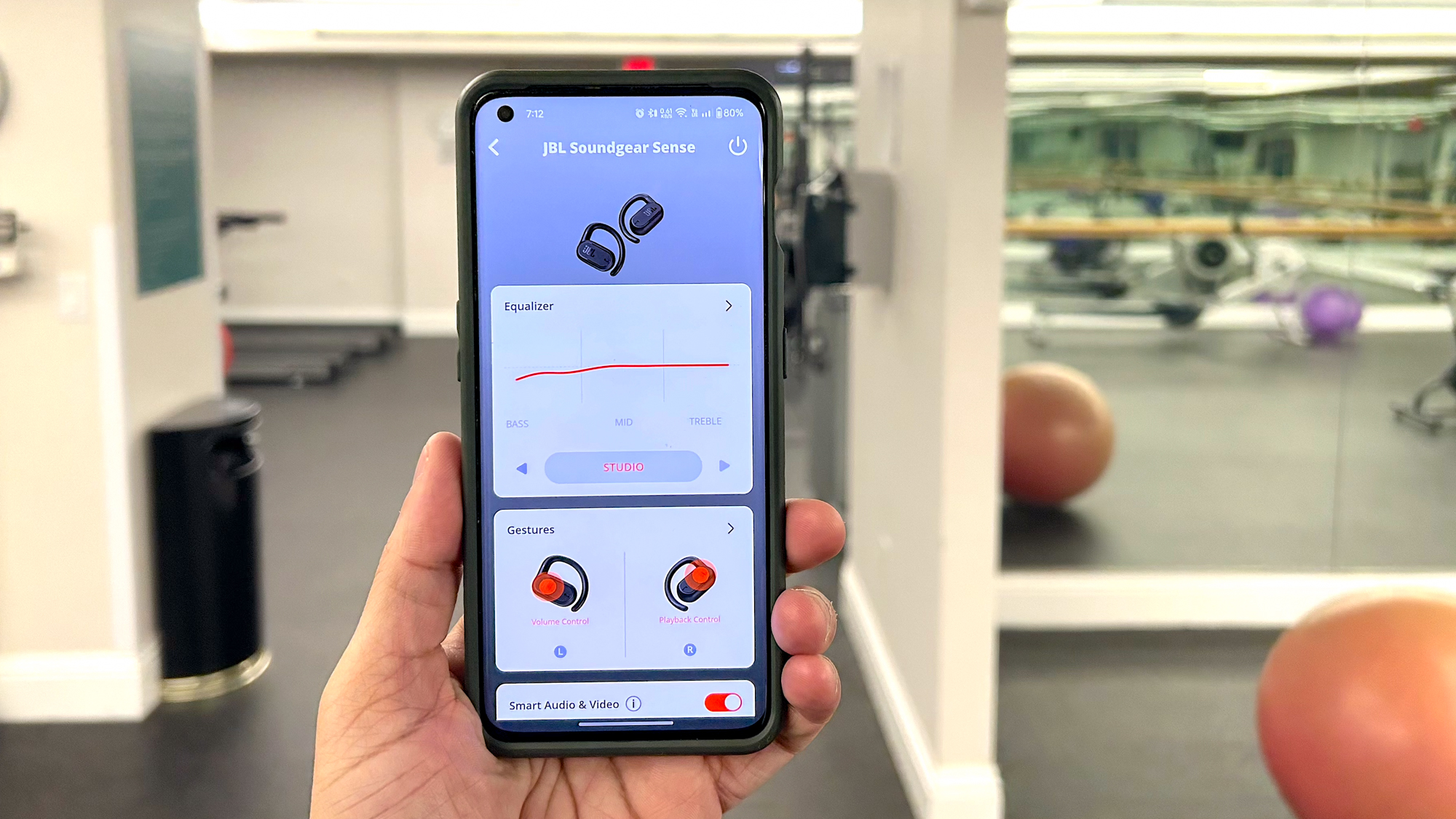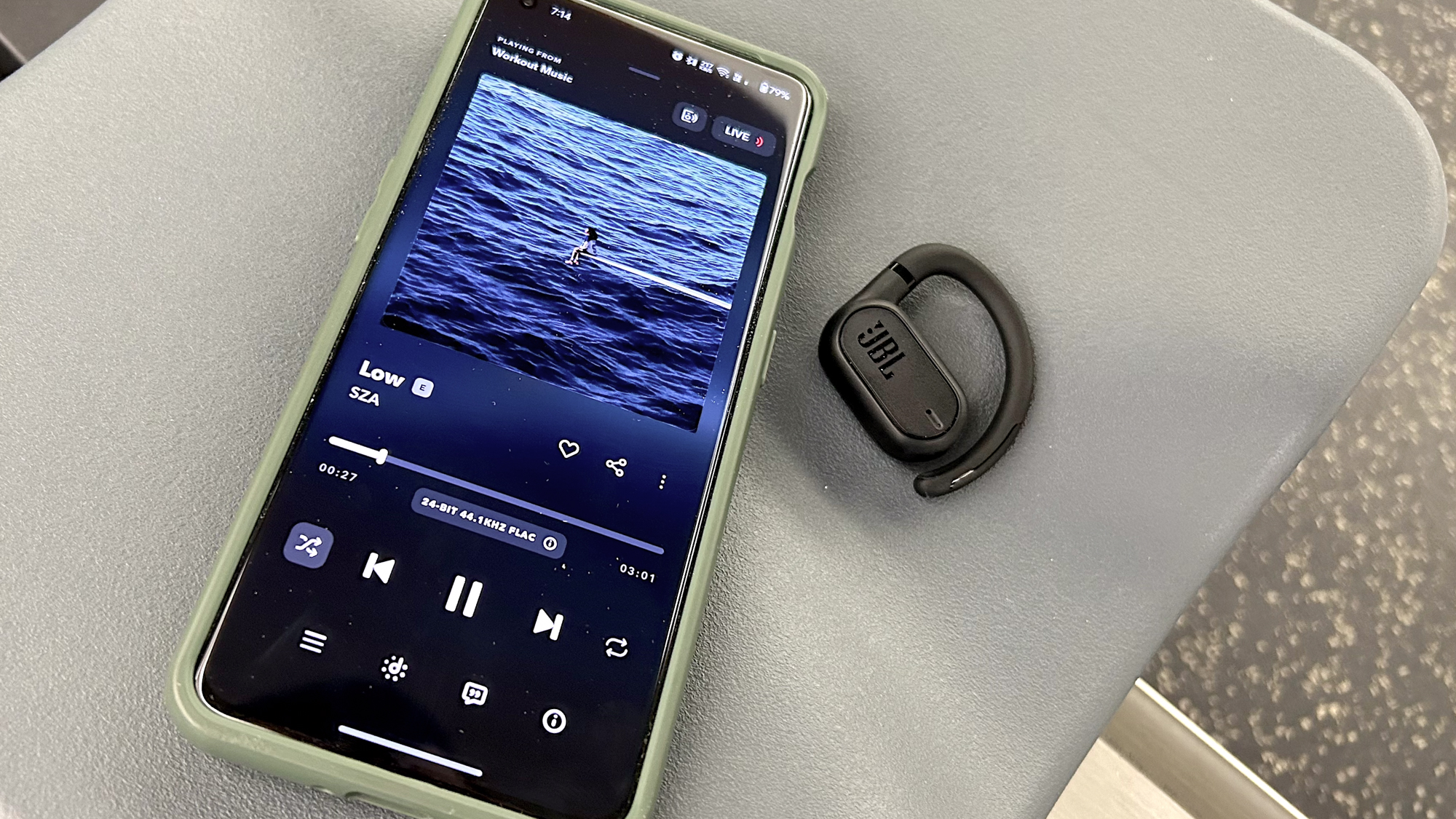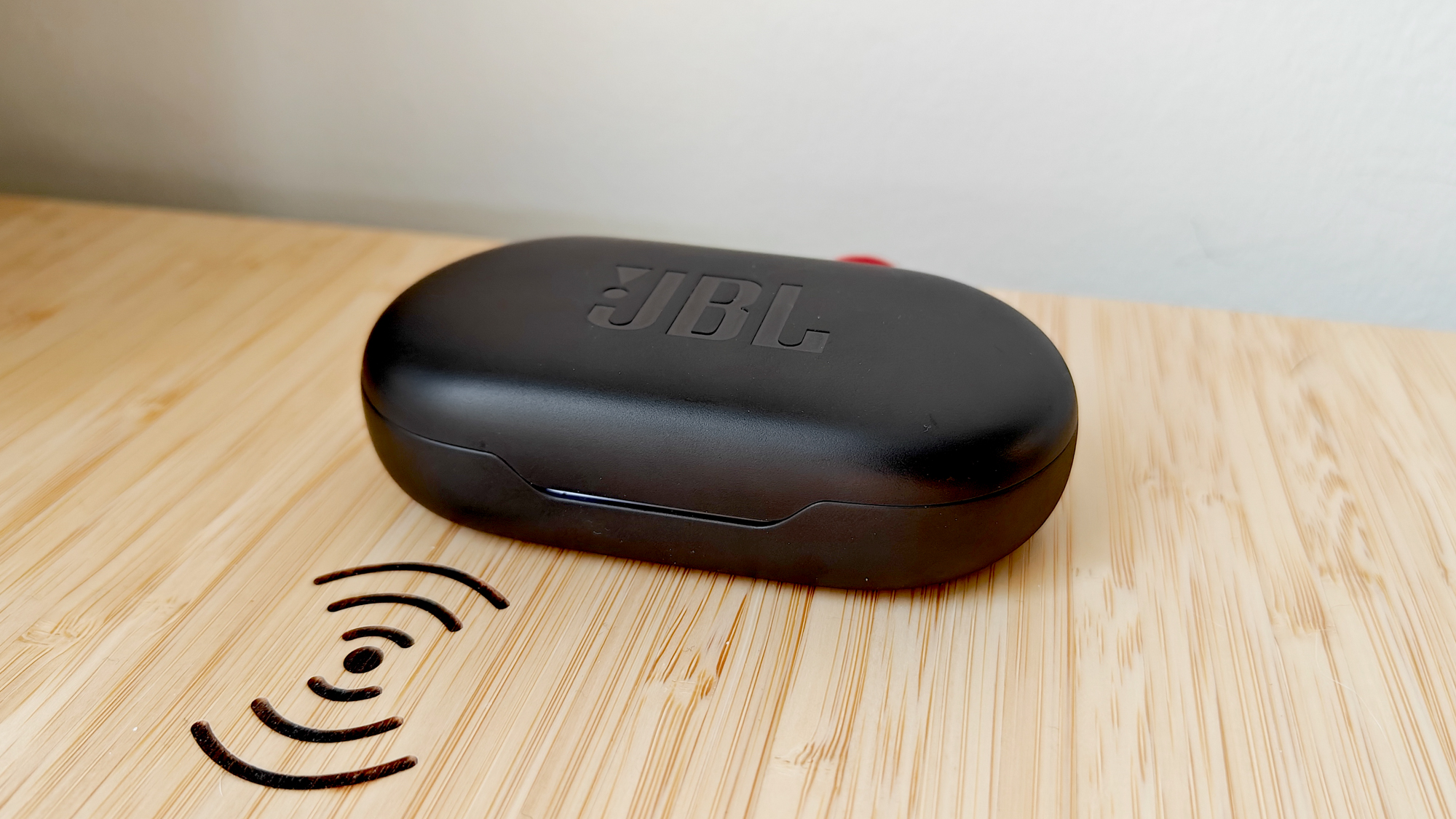Tom's Guide Verdict
The JBL Soundgear Sense sound better than most sporty open earbuds, but their lack of essentials warrants a lower MSRP.
Pros
- +
Dynamic, bass-forward sound
- +
Unique multi-angled fit
- +
Strong connectivity
- +
Responsive touch controls
Cons
- -
Uncomfortable
- -
Less features than most JBL wireless earbuds
- -
Disappointing battery life
- -
Let in too much noise
Why you can trust Tom's Guide
Price: $149 / £128 / AU$199
Colors: Black, white
Battery life (rated): 6 hours, 24 hours (charging case)
Connectivity: Bluetooth 5.3 with SBC, AAC
Size: Not stated
Weight: 0.46 ounces (per bud), 2.4 ounces (charging case)
Durability: IP54 rated
Open wireless earbuds are all the rage right now, especially among fitness fanatics. Releases like the Anker Soundcore AeroFit Pro and Bose Ultra Open Earbuds have surprised critics with their expansive functionality and inventive designs. JBL hopes to leave the same impression with the all-new Soundgear Sense.
These sporty buds utilize JBL’s OpenSound technology to deliver a natural sound experience that also keeps listeners highly aware of their surroundings. Brand staples such as bass-heavy audio, durable protection, and well-rounded connectivity come part of the package. So does a new adjustable open-ear design that lets in too much ambient noise and leaves ears feeling sore after workouts.
Read my full JBL Soundgear Sense review to discover whether they are a worthy partner for a life on the go.

JBL Soundgear Sense review: Price and availability
- On sale now priced at $149 / £128 / AU$199
- Black or white color options
The Soundgear Sense are listed at $149 / £128 / AU$199, falling into a price range similar to many of the best bone-conduction headphones. They also carry a lower price than the Soundcore AeroFit Pro ($169), which have a bigger spec sheet and are among my 'air conduction' headphone favorites.
The Soundgear Sense are available in black or white color options and can be purchased directly from JBL's website or Amazon.
JBL Soundgear Sense review: Design

- Adjustable hooks
- Neckband included for secure fit
- Uncomfortable to wear
The JBL Soundgear Sense have a minimalist design with debossed branding, long touch panels, and sturdy plastic construction. IP54 certification provides dustproofing and water resistance. JBL’s charging case is long, but its compactness and slim profile take up very little space in your gym bag.
The flexible hooks latch onto ears and form a secure fit that can be adjusted at different angles. JBL even threw in a neckband to wear the Soundgear Sense a more traditional way. Unfortunately, these buds apply unwanted pressure to the outer part of the ear that hurts after an hour of wear. Both of my ears were throbbing after short workouts.
Get instant access to breaking news, the hottest reviews, great deals and helpful tips.
JBL Soundgear Sense review: Features

- Companion app support via JBL Headphones app
- Some useful features like wear detection are missing
Recent JBL releases like the Live 670NC showcase the brand’s monstrous feature suite and capabilities. Sadly, the Soundgear Sense don't offer such a strong feature set. While I knew they wouldn’t receive every high-end JBL feature, I expected to see more functional perks.
Notable features in the JBL Headphones app are the custom Equalizer with multiple presets, Max Volume Limiter, Smart Audio & Video mode, and volume balance to adjust the volume level between each bud. Other notables include an auto-power setting, control assignment, Find My Buds mode, power off function, and battery level indicators for each bud and the charging case. Proprietary features like spatial audio and Personi-Fi to personalize sound are absent, as are basics like wear detection to auto-pause content when removing the buds.
JBL Soundgear Sense review: Controls

- Excellent touch controls
- Sensitive input feedback
- Solid digital assistance
These buds come with responsive touch panels that support multiple input methods. Single-/double-/triple-tap and long-hold gestures are instantly executed. Playback/call management (right bud), volume (left bud), and voice assistance (both buds) are accessible right out of the box, so you don’t have to assign these functions in the app.
I must warn you that touch accuracy is sensitive. There were times when content paused because the touch panels came in contact with fabric or my skin during overhead curl exercises.
Alexa, Google Assistant, and Siri are compatible with the Soundgear Sense. Android users can fire up Google’s virtual assistant via wake-word phrase (Hey Google) for hands-free usage. The function works well and JBL’s mic array demonstrates great speech recognition to interpret and perform voice commands with ease.
JBL Soundgear Sense review: Sound quality

- Effective audio with a punchy resonance
- Useful sound enhancement tools
- Ambient noise is very disruptive
The Soundgear Sense could arguably be the best-sounding model in the sub-category. Their elite bass response is superior to any in-class alternative. JBL’s 16.2mm drivers pump out striking lows that will revitalize exhausted runners, plus clear-sounding mids and highs, as long as you’re in a reasonably quiet area.
The drum-horn combination on Imagine Dragons’ “Enemy” was tight, while the rising synths elevated bass for a lively listen. I was surprised by how crisp certain elements sounded; the backing chorus and teetering hi-hats remain prominent over the booming production. SZA’s “Low” boosted adrenaline levels on the treadmill with an ethereal beat highlighted by growling lows. Recovery favorites like Ahmad Jamal Trio’s “Stolen Moments” fed my ears soothing double bass and piano notes that calmed my body during stretches.

Playing around with the JBL’s sound settings can be rewarding. The Max Volume Limiter stabilizes audio output to a specified level that won’t harm your hearing, though it isn’t necessary since the buds aren’t ridiculously loud like some wireless earbuds. Smart Audio & Video is vital for improving sound quality on songs and lip synchronization on videos, and the volume balance slider adjusts volume between channels accordingly. The real prize is JBL’s EQ, which can be manually adjusted to suit your frequency preference. It also comes with five presets – Bass, Clear, Jazz, Studio (aka the default), and Vocal – each well engineered for their intended purposes.
Audio codecs are limited to AAC (iOS/macOS) and SBC (Android). The good news is you’ll get adequate streaming quality across all devices and platforms. Tracks played smoothly on the best music streaming services.
No one is purchasing open earbuds for noise isolation. However, too much transparency can be detrimental to the listening experience, which the Soundgear Sense showed. Every incidental sound at the gym was audible, from the clanking noises made by weight machines to the pounding impact of runners’ feet on the treadmill. I don’t recall other open-ear models like the Bose Sport Open Earbuds or Sony LinkBuds letting in quite as much ambient noise.
JBL Soundgear Sense review: Call quality and connectivity

- Weak voice calling
- Pairing and wireless range hit their marks
According to JBL, the Soundgear Sense’s four-mic array produces “crisp, clear calls.” I beg to differ. Background noise marred indoor and outdoor conversations. Several friends also complained about muffle and poor clarity on my end. Wind only worsened call quality with harmful whooshing effects.
Bluetooth 5.3 was a brighter spot. The buds connected and re-paired instantly to recognizable devices, specifically Android smartphones, which have one-tap Google Fast Pair. Range extended up to 50 feet before stuttering. One main reason to consider the Soundgear Sense is multipoint technology, to pair the buds with two devices simultaneously. The feature handled dual connectivity very well and didn’t scramble transmissions when switching devices.
JBL Soundgear Sense review: Battery life

- 6 hours of playtime
- No wireless charging
Battery life is short at 6 hours per charge. Upscale features (e.g., multipoint, Smart Audio & Video) decrease playtime by 1 hour. That’s close to the original AirPods (5 hours) and far less than what the AeroFit Pro offer (14 hours). I had to recharge these buds every 1.5 days.
The non-wireless charging case holds up to 24 hours, which, again, is original AirPods territory. JBL’s quick charging doesn’t impress much either; a 15-minute charge equates to 4 hours of listening time.
JBL Soundgear Sense review: Verdict
There is some value to the Soundgear Sense. A tough modular design isn’t something you’ll find on many in-class rivals. Neither is an energetic, warm soundstage that can be personalized in various ways. Then again, $150 seems a bit steep when factoring in the model’s impractical flaws.
A price drop to $120 or even $100 would make these buds a worthy pickup for active lifestylers who want to enjoy their workout music and monitor their environment at the same time. Otherwise, I recommend spending a little extra on the AeroFit Pro for adaptive sound and longer battery life.
More from Tom's Guide
- I ditched AirPods Pro for Bose Ultra Open Earbuds, here's what happened
- I tried these $99 wired earbuds and they're perfect for audiophiles
- Best audiophile headphones tested and rated
A lifestyle journalist with an affinity for consumer products, Alex has over a decade of experience and has worked with popular publications such as Complex, Thrillist, Men’s Health, Gear Patrol, AskMen, and Hoop Magazine. He currently focuses on audio, reviewing the most coveted headphones in the market for both Tom’s Guide and Laptop Magazine.


